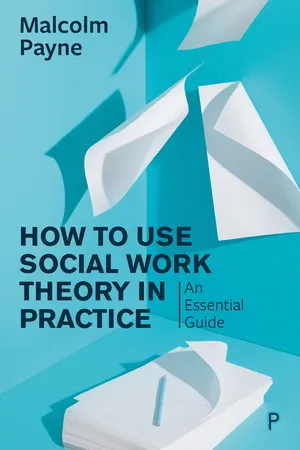
- 288 pages
- English
- ePUB (mobile friendly)
- Available on iOS & Android
About this book
Social work theory is full of ideas about how to practise. It guides you in what to do as well as how to approach and think about social work goals.
In this clear and systematic book covering both general practice concepts and theoretical insights, best-selling author Malcolm Payne shows you how to work with the main theories and practice techniques and pinpoint their strengths and limitations.
This book:
• Explores the social work process from first to last contact;
• Covers all the theories and methods you need to know as a practitioner;
• Examines practice techniques and the ideas that inform them;
• Includes helpful chapter-by-chapter infographics.
This practical guide condenses the practical features of social work theory but doesn't oversimplify them. Students and practitioners can confidently put their knowledge into action and see how everyday practice implements theoretical ideas. It will be an invaluable resource to students and newly qualified practitioners in social work and in related fields of practice, making connections with both classic and contemporary movements in social work.
Frequently asked questions
- Essential is ideal for learners and professionals who enjoy exploring a wide range of subjects. Access the Essential Library with 800,000+ trusted titles and best-sellers across business, personal growth, and the humanities. Includes unlimited reading time and Standard Read Aloud voice.
- Complete: Perfect for advanced learners and researchers needing full, unrestricted access. Unlock 1.4M+ books across hundreds of subjects, including academic and specialized titles. The Complete Plan also includes advanced features like Premium Read Aloud and Research Assistant.
Please note we cannot support devices running on iOS 13 and Android 7 or earlier. Learn more about using the app.
Information
Table of contents
- Cover
- Title Page
- Copyright Page
- Contents
- List of infographics
- Some of the terms that I use in this book
- How to use this book
- How to read the infographics
- 1. Introduction: practice from social work theory
- 2. First contact and engagement
- 3. Assessment
- 4. Communication, advice, information
- 5. Counselling
- 6. Resilience, risk, safeguarding
- 7. Humanistic person-centred practice
- 8. Mindfulness practice
- 9. Strengths and solution-focused practice
- 10. Narrative practice
- 11. Psychodynamic relationship-based practice
- 12. Attachment practice
- 13. Task-centred practice
- 14. Crisis practice
- 15. Cognitive behavioural therapy (CBT) practice
- 16. Motivational interviewing
- 17. Advocacy, human rights and welfare rights
- 18. Empowerment, anti-oppressive practice and power
- 19. Groupwork
- 20. Community work and macro practice
- 21. Systems practice
- 22. Critical and structural practice
- 23. Feminist practice
- 24. Ecological and green practice
- 25. Ending and critical reflection
- Bibliography